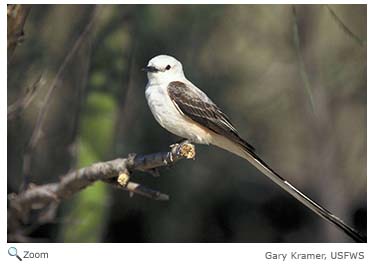Tyrannidae - New World or Tyrant Flycatchers |
|
|
 There are over 400 species in this family. The are found in North, Central, and South America and in the Caribbean. Most species are found in tropical areas. There are over 400 species in this family. The are found in North, Central, and South America and in the Caribbean. Most species are found in tropical areas.
Tyrant flycatchers are small to medium-sized birds between 3-16 inches in length. They are usually gray, brown or olive-green in color, although some species are more brightly colored.
Some species have crests that are more colorful than the rest of their plumage. Tyrant flycatchers eat insects.
World Status Key
 Least Concern Least Concern  Near Threatened Near Threatened  Vulnerable Vulnerable  Endangered Endangered  Critically Endangered Critically Endangered  Extinct in Wild Extinct in Wild  Extinct Extinct  Not Enough Data Not Enough Data
Status and range is taken from ICUN Redlist.
Location Key
 Africa Africa  Asia Asia  Australia/Oceania Australia/Oceania  Europe Europe  North America North America  South America South America  NH NH  Click for More Info Click for More Info  Click for Image Click for Image
Additional Information
Key:  Profile Profile  Photos Photos  Video Video  Audio Audio
Olive-sided Flycatcher - Contopus cooperi         
The olive-sided flycatcher breeds in Alaska, Canada and much of the northern and western U.S. It winters in Mexico, Central and South America.
Source: Cornell Lab of Ornithology Intended Audience: General Reading Level: Middle School Teacher Section: No
Olive-sided Flycatcher - Contopus cooperi         
The olive-sided flycatcher eats insects.
Source: HBW Alive Intended Audience: General Reading Level: Middle School Teacher Section: No
Olive-sided Flycatcher - Contopus cooperi       
The olive-sided flycatcher breeds at the edges and in the openings of coniferous forests.
Source: Arkive Intended Audience: General Reading Level: Middle School Teacher Section: Yes
Eastern Wood-Pewee - Contopus virens        
The eastern wood-pewee is a neotropical migrant. It breeds from south central and southeastern Canada to the Gulf coast and Florida. It winters in northwestern South America in Colombia, Venezuela, Ecuador, Peru, and Brazil.
Source: Cornell Lab of Ornithology Intended Audience: General Reading Level: Middle School Teacher Section: No
Eastern Wood-Pewee - Contopus virens       
During breeding season, the eastern wood-peewee is usually found in deciduous forests, although is can also be found in coniferous and mixed forests.
Source: Audubon Intended Audience: General Reading Level: Middle School Teacher Section: No
Eastern Wood-Pewee - Contopus virens       
The eastern wood-peewee is an insectivore.
Source: Animal Diversity Web Intended Audience: General Reading Level: Middle School Teacher Section: No
Eastern Wood-Pewee - Contopus virens         
The eastern wood-peewee migrates at night..
Source: HBW Alive Intended Audience: General Reading Level: Middle School Teacher Section: No
Alder Flycatcher - Empidonax alnorum        
The alder flycatcher breeds from Alaska east to the Canadian maritime provinces south to the northern U.S., the Great Lakes region and much of the northeastern U.S. It winters in South America.
Source: Cornell Lab of Ornithology Intended Audience: General Reading Level: Middle School Teacher Section: No
Alder Flycatcher - Empidonax alnorum        
The alder flycatcher eats insects, but it sometimes eats spiders, berries, and seeds.
Source: Audubon Intended Audience: General Reading Level: Middle School Teacher Section: No
Alder Flycatcher - Empidonax alnorum        
The alder flycatcher breeds from Mid-June to early August.
Source: HBW Alive Intended Audience: General Reading Level: Middle School Teacher Section: No
Alder Flycatcher - Empidonax alnorum        
The alder flycatcher and the willow flycatcher look so much alike that they were once though to be the same species.
Source: Arkive Intended Audience: General Reading Level: Middle School Teacher Section: Yes
Yellow-bellied Flycatcher - Empidonax flaviventris       
The yellow-bellied flycatcher breeds across much of Canada and the northern U.S. from North Dakota to the northeast U.S. It winters in Mexico and Central America.
Source: Cornell Lab of Ornithology Intended Audience: General Reading Level: Middle School Teacher Section: No
Yellow-bellied Flycatcher - Empidonax flaviventris       
During breeding season the yellow-bellied flycatcher can be found in spruce bogs and damp forests.
Source: Audubon Intended Audience: General Reading Level: Middle School Teacher Section: No
Yellow-bellied Flycatcher - Empidonax flaviventris       
The yellow-bellied flycatcher nests on the ground.
Source: HBW Alive Intended Audience: General Reading Level: Middle School Teacher Section: No
Least Flycatcher - Empidonax minimus       
The least flycatcher breeds across much of Canada and the northern U.S. It winters in Mexico and Central America.
Source: Cornell Lab of Ornithology Intended Audience: General Reading Level: Middle School Teacher Section: No
Least Flycatcher - Empidonax minimus       
The least flycatcher breeds in deciduous or mixed woodlands.
Source: Audubon Intended Audience: General Reading Level: Middle School Teacher Section: No
Least Flycatcher - Empidonax minimus        
The least flycatcher migrates at night.
Source: HBW Alive Intended Audience: General Reading Level: Middle School Teacher Section: No |